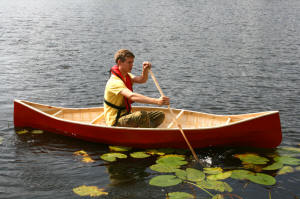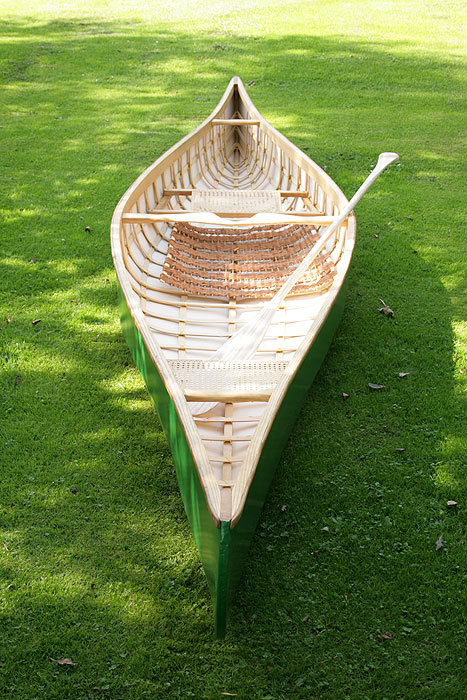My Third Skin on Frame Canadian Style Canoe...
The following story will be updated as and when I complete
new stages...
Some of you may remember a couple of skin on frame canoes i made a few years ago. Well i'm making another and thought i'd share the process with you all again...
You can follow the progress on my website too, where you will probablly find the story will be updated first. The story is shown as a blog post on my home page here: (Images can be enlarged on my website too)
http://www.jonsbushcraft.com
Hope this story inspires some of you to have a go at building a canoe yourself, its really not so hard and you dont need to buy fancy wood.
The story begins...
___________________________________________________
After all the fun and enjoyment I've had out of my last two
skin on frame canoes, I have decided to build another one, this
time it will be a two man canoe in the same Canadian style that
I like so much. There are no plans for the canoe I am building
all I know is that I want it to be around 4.5 meters long and
about 90cm wide at the centre Most of the jobs will just be done
by eye.
This is not a canoe made from 100% wild materials like a
birch bark canoe, but a mix of traditional wood working skills,
some cotton canvas and even a few wood screws. The emphasis for
me is always on doing a proper job, speed is not the essence. I
am always reluctant to use power tools as I feel mistakes can be
made quickly with such hasty devices. Hand tools fit better with
my calm and patient nature anyway.
Construction begins...
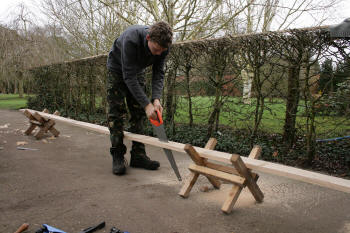
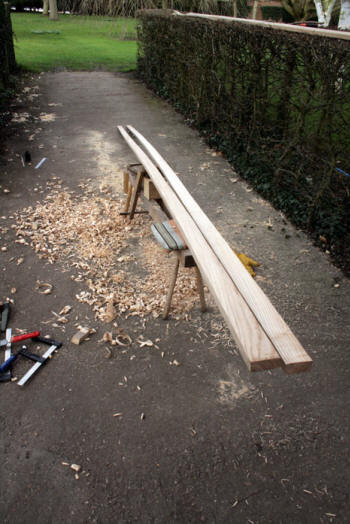
To start I've purchased a plank of naturally air dried Ash wood from the timber
yard about 7" x 1" x 5m. At first I wanted to use a long sapling from the woods
to fashion my Gunnels from but I was unable to locate one straight and long
enough for my needs. By purchasing the plank I would also have enough wood for
many other parts too such as the long keel baton etc. The wood didn't come cheap
though... about £90 for this one plank!
The first job was to rip cut along the length to cut off two laths suitable
for Gunnels. This job could be done with a circular saw but I am quite stubborn
and don't like to use power tools all that much
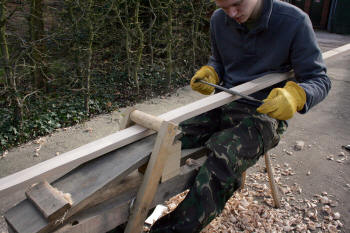
Using a Shave horse and Draw Kinfe I then worked the two gunnels
down to final dimensions which is about 20mm x 55mm. I then made a gradual taper
towards the ends shaving it down to about 3cm high with no change to the
width.
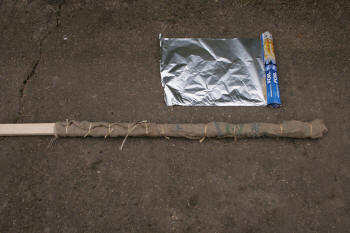
Now it was time to steam bent these tapered ends upwards which
will give my canoe some nice curves (known as Indian ends). I am using quite a
simple but effective method to steam the wood. Firstly I wrap the wood in
Hessian material, then give it a good soaking and finally wrap it up in tin
foil. Then I cook the wood over the fire like a fish. The wood doesn't burn if
the material is wet enough.
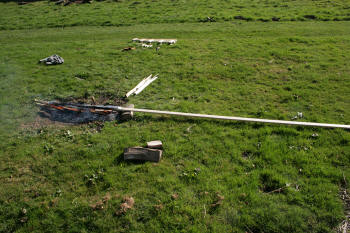
Here you can see the wood propped up over a long fire. As a general rule wood
needs steaming for an hour per inch of thickness. My wood was only 20mm thick
but I steamed it for 1 and a half hours for good measure.
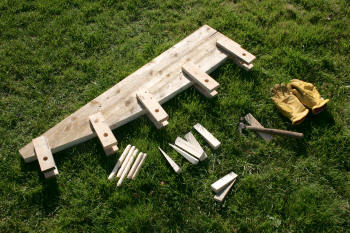
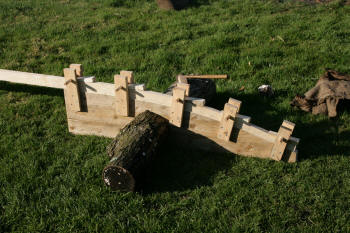
Here you can see the form I have made to clamp the Gunnel ends into the
desired shape. (you also have to allow for the wood to relax a little, so make
the form curve more extreme) The clamp works by first inserting a dowel peg
above the wood and then tapping a wedge between the wood and the peg to securely
hold the wood in shape. The wood then needs to be kept in the clamp for several
days to let it dry and take it's new shape properly. You can see that with four
Gunnel ends to steam bend this process takes considerable time! Having two forms
would speed things up.
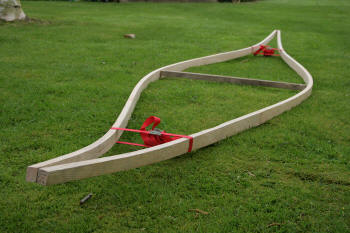
Using some cam straps and a scrap piece of wood, the first curves of the canoe
can be seen... It's key stages like this that spur you on to do the next job...
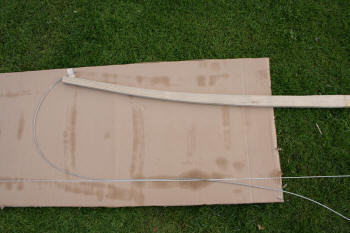
Before fixing the gunnels together with proper cross members
(called 'Thwarts') I wanted to gauge what shape stem pieces I would like for the
ends of my canoe. I did this by lying a Gunnel on the lawn with a piece of
cardboard under it. I measured out the intended final depth of the canoe and
marked it with a line of cord. Then using a metal cable I could make various
curves to envisage what I would like the end of the canoe to look like. I then
drew around the cable onto the cardboard, I'll use this shape as a template
later on when I make another form to steam bend the stem pieces into shape.
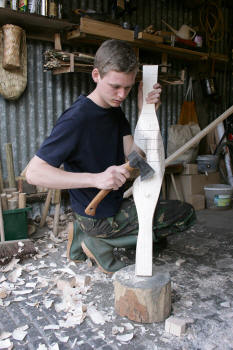
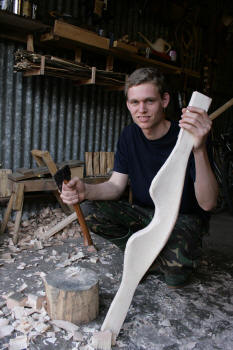
Here I am carving the 'Yoke' which is a type of central thwart
used for carrying the canoe on your shoulders. (If you can remember, a very
similar type of yoke was used in the old days for carrying two buckets of water
on the shoulders.)
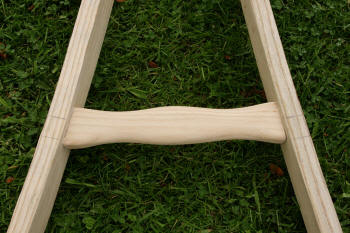
I made two smaller thwarts to be installed near to the ends. A draw knife, rasp, file and cabinet scraper are the key tools for making such pieces. I have simply screwed these in place with rust proof screws
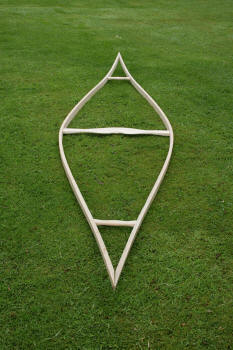
The yoke is also fixed in place at dead centre for perfect balance.
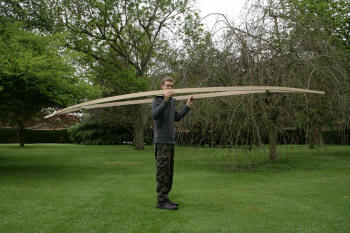
The yoke in action
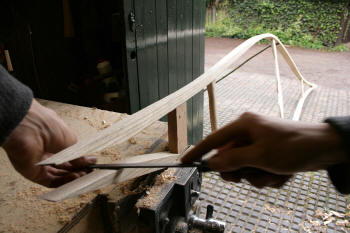
The ends of the gunnels needed to be shaped to they are ready for receiving the stem pieces. I know that my stem configuration will be 2cm thick so I can use a scrap block of wood to test the fit and get the angles correct for now. I used another temporary piece of wood to wedge open the gunnels so that I have room to work on the joint with tools like a rasp.
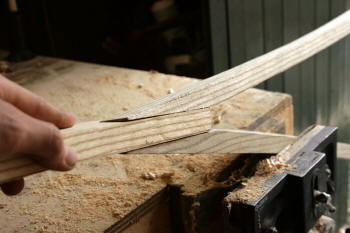
Constantly testing the fit until complete...
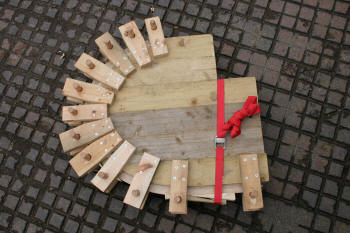
Now it was time for making the stem pieces... I made this form using the cardboard template I made earlier as a guide. I had to make the curve more extreme as the wood relaxes by a few inches when it is released from the form. Making such a form take a lot of time in itself...
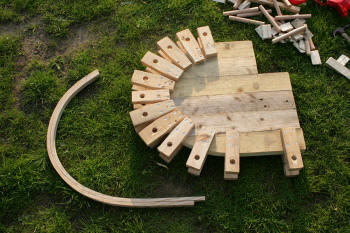
On my first attempt the wood snapped so I decided to make each stem piece from a lamination of two pieces of wood instead. (i want the final stems to be 20mm wide by 1 inch thick. I am using Ash wood pieces 106cm long) Thinner pieces of wood bend much more easily and are far less likely to fracture. You can see here the two pieces have been bent successfully and removed from the form after a few days.
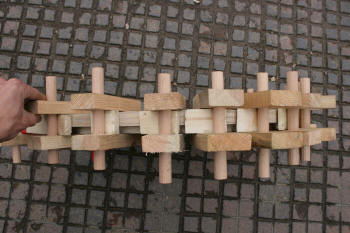
From this picture you can see how dowel pegs and wedges work to hold the wood in place. The wood was steamed once again in soaked Hessian and tin foil over the fire. Once taken off the fire you have to work swiftly to get the wood bent into shape before it cools down too much.
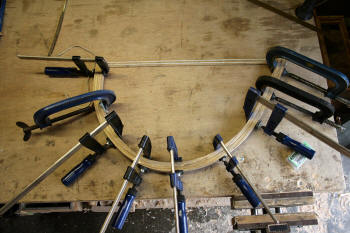
The two halves now needed to be glued together, I used an epoxy
resin branded 'Bob Smith'. The wood had relaxed a little more than I had wanted
so I tied the two ends together bringing the wood into shape (I tied the cord in
place through two holes drilled through spare wood at the ends). Clamps ensure
the glue takes a good tight bond.
Now I needed to repeat the whole procedure to make the second stem piece.
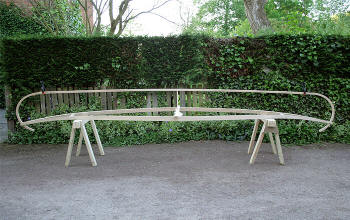
With the stems made I sawed another length of wood off my plank for the keel baton, I also like to plane and smooth off all the parts, the baton dimensions are 20mm x 25mm x however long. I could now clamp the parts together to get an impression of the shape.
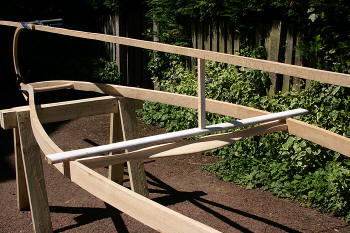
I want the canoe to be about 14 inches deep at the centre, I made this T shaped prop to temporarily hold up the keel baton to the right height at the centre whilst I work out measurements etc for the next stages.
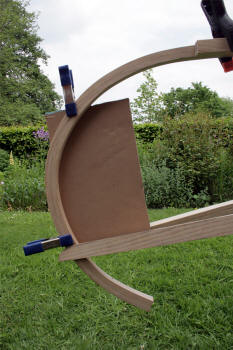
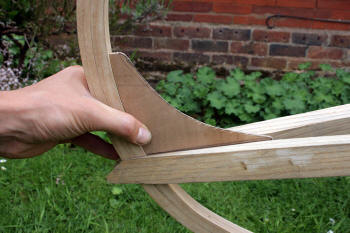
With everything clamped in place I needed to make a couple of brackets which
allow me to securely join the stems to the gunnels. To work out the shape of
these brackets I made a cardboard template. I held the cardboard in place
between the gunnel and the stem, I could then draw the profile of the stem
against the card and cut the template out acordingly. You can see the complete
shape above
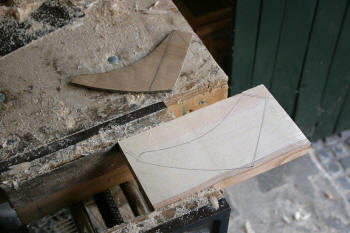
I transferred the shape to some wood I had split and shaved out of a log and cut
it to shape with a hatchet, saw and rasp.

You can see here how this bracket is going to make a strong connection between
the stem and gunnels.
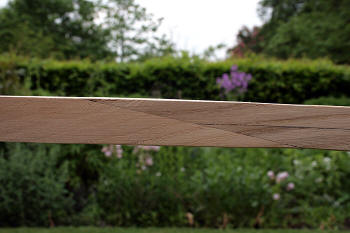
Before permanently securing all these parts together I joined the stems and keel
baton together first with a simple splice join. I used epoxy glue and clamps. I
smooth off any joins so they are as seamless as possible using a plane, rasp and
cabinet scraper.
Update: Full article HERE
The following story will be updated as and when I complete
new stages...
Some of you may remember a couple of skin on frame canoes i made a few years ago. Well i'm making another and thought i'd share the process with you all again...
You can follow the progress on my website too, where you will probablly find the story will be updated first. The story is shown as a blog post on my home page here: (Images can be enlarged on my website too)
http://www.jonsbushcraft.com
Hope this story inspires some of you to have a go at building a canoe yourself, its really not so hard and you dont need to buy fancy wood.
The story begins...
___________________________________________________
After all the fun and enjoyment I've had out of my last two
skin on frame canoes, I have decided to build another one, this
time it will be a two man canoe in the same Canadian style that
I like so much. There are no plans for the canoe I am building
all I know is that I want it to be around 4.5 meters long and
about 90cm wide at the centre Most of the jobs will just be done
by eye.
This is not a canoe made from 100% wild materials like a
birch bark canoe, but a mix of traditional wood working skills,
some cotton canvas and even a few wood screws. The emphasis for
me is always on doing a proper job, speed is not the essence. I
am always reluctant to use power tools as I feel mistakes can be
made quickly with such hasty devices. Hand tools fit better with
my calm and patient nature anyway.
Construction begins...


To start I've purchased a plank of naturally air dried Ash wood from the timber
yard about 7" x 1" x 5m. At first I wanted to use a long sapling from the woods
to fashion my Gunnels from but I was unable to locate one straight and long
enough for my needs. By purchasing the plank I would also have enough wood for
many other parts too such as the long keel baton etc. The wood didn't come cheap
though... about £90 for this one plank!
The first job was to rip cut along the length to cut off two laths suitable
for Gunnels. This job could be done with a circular saw but I am quite stubborn
and don't like to use power tools all that much

Using a Shave horse and Draw Kinfe I then worked the two gunnels
down to final dimensions which is about 20mm x 55mm. I then made a gradual taper
towards the ends shaving it down to about 3cm high with no change to the
width.

Now it was time to steam bent these tapered ends upwards which
will give my canoe some nice curves (known as Indian ends). I am using quite a
simple but effective method to steam the wood. Firstly I wrap the wood in
Hessian material, then give it a good soaking and finally wrap it up in tin
foil. Then I cook the wood over the fire like a fish. The wood doesn't burn if
the material is wet enough.

Here you can see the wood propped up over a long fire. As a general rule wood
needs steaming for an hour per inch of thickness. My wood was only 20mm thick
but I steamed it for 1 and a half hours for good measure.


Here you can see the form I have made to clamp the Gunnel ends into the
desired shape. (you also have to allow for the wood to relax a little, so make
the form curve more extreme) The clamp works by first inserting a dowel peg
above the wood and then tapping a wedge between the wood and the peg to securely
hold the wood in shape. The wood then needs to be kept in the clamp for several
days to let it dry and take it's new shape properly. You can see that with four
Gunnel ends to steam bend this process takes considerable time! Having two forms
would speed things up.

Using some cam straps and a scrap piece of wood, the first curves of the canoe
can be seen... It's key stages like this that spur you on to do the next job...

Before fixing the gunnels together with proper cross members
(called 'Thwarts') I wanted to gauge what shape stem pieces I would like for the
ends of my canoe. I did this by lying a Gunnel on the lawn with a piece of
cardboard under it. I measured out the intended final depth of the canoe and
marked it with a line of cord. Then using a metal cable I could make various
curves to envisage what I would like the end of the canoe to look like. I then
drew around the cable onto the cardboard, I'll use this shape as a template
later on when I make another form to steam bend the stem pieces into shape.


Here I am carving the 'Yoke' which is a type of central thwart
used for carrying the canoe on your shoulders. (If you can remember, a very
similar type of yoke was used in the old days for carrying two buckets of water
on the shoulders.)

I made two smaller thwarts to be installed near to the ends. A draw knife, rasp, file and cabinet scraper are the key tools for making such pieces. I have simply screwed these in place with rust proof screws

The yoke is also fixed in place at dead centre for perfect balance.

The yoke in action

The ends of the gunnels needed to be shaped to they are ready for receiving the stem pieces. I know that my stem configuration will be 2cm thick so I can use a scrap block of wood to test the fit and get the angles correct for now. I used another temporary piece of wood to wedge open the gunnels so that I have room to work on the joint with tools like a rasp.

Constantly testing the fit until complete...

Now it was time for making the stem pieces... I made this form using the cardboard template I made earlier as a guide. I had to make the curve more extreme as the wood relaxes by a few inches when it is released from the form. Making such a form take a lot of time in itself...

On my first attempt the wood snapped so I decided to make each stem piece from a lamination of two pieces of wood instead. (i want the final stems to be 20mm wide by 1 inch thick. I am using Ash wood pieces 106cm long) Thinner pieces of wood bend much more easily and are far less likely to fracture. You can see here the two pieces have been bent successfully and removed from the form after a few days.

From this picture you can see how dowel pegs and wedges work to hold the wood in place. The wood was steamed once again in soaked Hessian and tin foil over the fire. Once taken off the fire you have to work swiftly to get the wood bent into shape before it cools down too much.

The two halves now needed to be glued together, I used an epoxy
resin branded 'Bob Smith'. The wood had relaxed a little more than I had wanted
so I tied the two ends together bringing the wood into shape (I tied the cord in
place through two holes drilled through spare wood at the ends). Clamps ensure
the glue takes a good tight bond.
Now I needed to repeat the whole procedure to make the second stem piece.

With the stems made I sawed another length of wood off my plank for the keel baton, I also like to plane and smooth off all the parts, the baton dimensions are 20mm x 25mm x however long. I could now clamp the parts together to get an impression of the shape.

I want the canoe to be about 14 inches deep at the centre, I made this T shaped prop to temporarily hold up the keel baton to the right height at the centre whilst I work out measurements etc for the next stages.


With everything clamped in place I needed to make a couple of brackets which
allow me to securely join the stems to the gunnels. To work out the shape of
these brackets I made a cardboard template. I held the cardboard in place
between the gunnel and the stem, I could then draw the profile of the stem
against the card and cut the template out acordingly. You can see the complete
shape above

I transferred the shape to some wood I had split and shaved out of a log and cut
it to shape with a hatchet, saw and rasp.

You can see here how this bracket is going to make a strong connection between
the stem and gunnels.

Before permanently securing all these parts together I joined the stems and keel
baton together first with a simple splice join. I used epoxy glue and clamps. I
smooth off any joins so they are as seamless as possible using a plane, rasp and
cabinet scraper.
Update: Full article HERE
Last edited:

